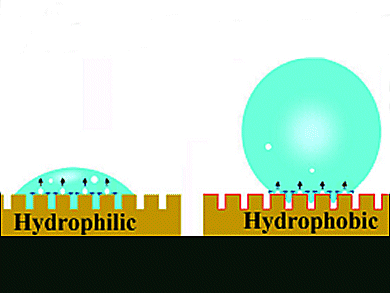With the discovery of novel wetting phenomena in nature like the self-cleaning effect of lotus leaves surfaces, surfaces with special wettability have attracted significant attention and have become increasingly important in our daily lives.
Surface wettability at non-ambient temperature, especially at temperatures above 100 °C, is of great importance in many industrial processes. The effect of chemical composition and surface morphology on the wetting behavior at high temperature has not been studied systematically.
Jingming Wang, Chinese Academy of Sciences, Beijing, China, and colleagues investigated the typical wetting transition on micro- and nanostructured surfaces with different wettabilities at temperatures from 20 – 200 °C. The spreading and bouncing behavior varies on substrates with different wettabilities as shown on the picture (substrate brown, water droplet blue, water vapor white). The bouncing temperature changes when the microstructure of the surface changes.
The researchers proposed two mechanisms of wetting at high temperature which explain the transition phenomena well.
- High-Temperature Wetting Transition on Micro- and Nanostructured Surfaces,
Tong Zhang, Jingming Wang, Li Chen, Jin Zhai, Yanlin Song, Lei Jiang
Angew. Chem. Int. Ed. 2011, 50, 5311–5314.
DOI: 10.10027anie.201007262




